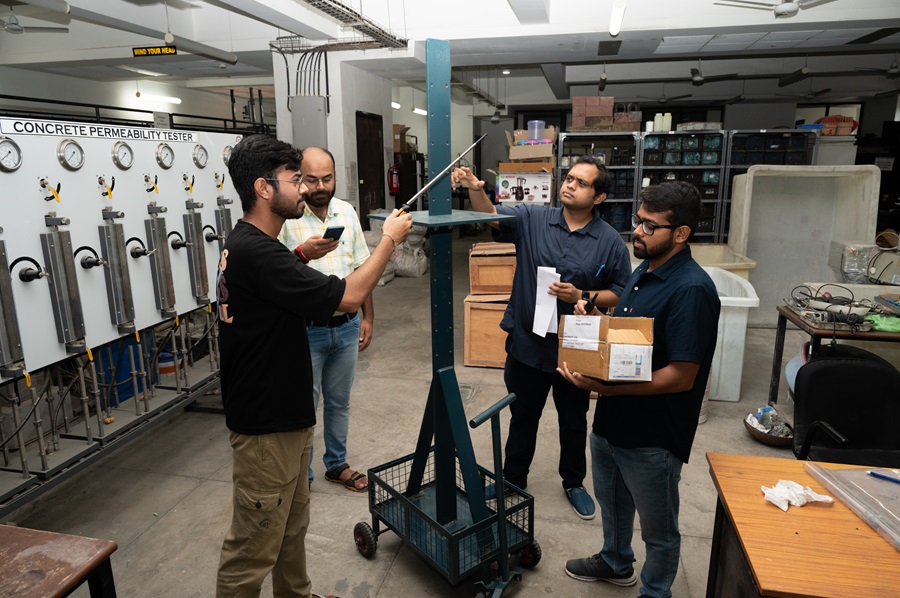STORY CREDITS
Writer: Tanumita Misra
Photo: Arijit Reeves
From crowded streets to towering skyscrapers, cities create their urban microclimates, which are localised climates that differ from the surrounding rural areas. To explore these unique weather patterns, researchers at the Built Environment Lab of IIT Gandhinagar have developed a mobile and portable weather cart named WxCart for a detailed study of urban microclimate.
The WxCart is a custom-made compact unit instrumented with sensors to measure various meteorological variables like air temperature, relative humidity, and wind speed at microscale levels. Unlike traditional stationary or large weather stations with limited reach, this mobile weather cart can easily navigate alleys and congested urban areas. “The WxCart is a game-changer for urban meteorology,” said Prof Sushobhan Sen, Assistant Professor in the Department of Civil Engineering, who is leading the project. “Its mobility ensures that we can gather precise, real-time data from diverse urban settings, capturing the significant microclimate variations in urban environments that often go unnoticed by the static stations.”
Shaping Climate Solution for Indian Cities
Focusing on the unique urban landscapes of Indian cities, this project sets itself apart from the previously conducted studies that have primarily explored temperate climates prevailing in Europe and North America. Urban morphology and climate conditions in these regions differ significantly from those in India. Unlike their Western counterparts, Indian cities tend to grow organically, featuring irregular urban morphology that incorporates starkly distinct characteristics (including blue and green infrastructure) over short distances. This lack of uniformity, influenced by India’s distinct hot, dry seasons and contrasting cool, wet monsoons, presents microclimatic conditions strikingly different from those in temperate regions.
“The WxCart is tailored to address these challenges, offering a novel approach to studying microclimate in Indian cities,” said Dr Sumit Nandi, a postdoctoral research fellow in the Department of Civil Engineering, who has actively worked towards the development and instrumentation of WxCart. “Its ability to sense meteorological variables at very small spatial scales makes it particularly well-suited for this task.”
A Year-Long Study to Map Microclimates
Currently, the team is in the process of collecting meteorological data over an entire weather cycle, which will be integrated with Energy Balance Models (EBMs). EBMs are mathematical tools that assess the balance between incoming solar energy and outgoing heat energy to study climate patterns. “This integration is crucial for mapping the most heat-prone zones in urban areas and understanding how it impacts human thermal comfort,” explained Dr Nandi. By combining WxCart data with EBMs, researchers aim to identify Urban Heat Island (UHI) hotspots—areas within cities that experience higher temperatures due to factors like building materials and lack of green space. The determination of UHIs will enable more effective strategies for optimising green space placement, improving ventilation designs, and selecting materials that mitigate heat retention.
Toward Sustainable Urban Living
In an era of rapid urbanisation and growing concerns about climate change, the WxCart represents a significant leap forward in understanding and addressing the environmental challenges of the future. “The data we’re collecting could lay the groundwork for shaping cities of the future,” Dr Nandi exclaimed. “Our goal is to use these findings to guide urban development in a way that enhances human thermal comfort and sustainability.”
The data collected by WxCart can be integrated into public information systems, providing real-time weather updates and fostering greater awareness of climate change and sustainable urban living. “By making this data accessible to the public, we hope to provide urban planners and policymakers with insights that can lead to more sustainable and comfortable cities,” added Professor Sen. The team believes that by making the collected data accessible to the public, they can help communities make informed decisions about adapting to and mitigating the effects of climate change.
The other team members who have contributed to the project include Dr Shubham Verma, a postdoctoral researcher in Civil Engineering, and a PhD scholar, Mr Chirag Nagar.

